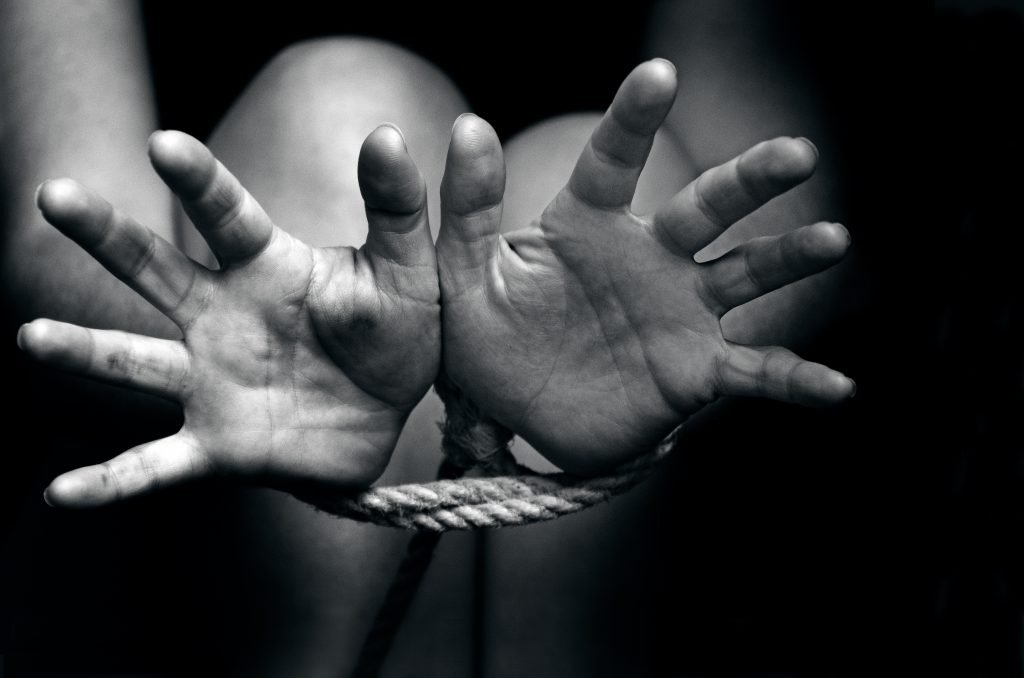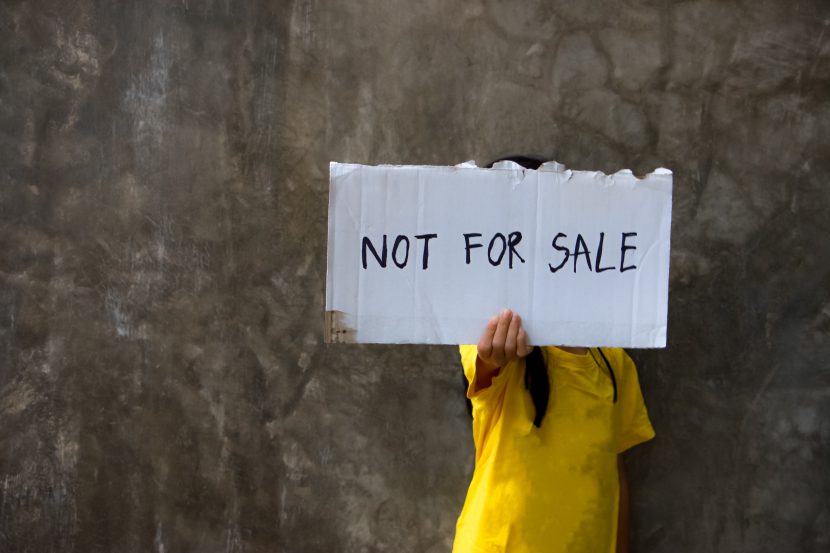Today, July 30, is the international day against the trafficking of human beings. For perpetrators, human trafficking is probably the most profitable violation of human rights; according to estimates, they make a profit of 150 billion dollars a year (ILO, 2014, p.13). Every day, traffickers trade thousands of people like goods and sell them for exploitation purposes such as prostitution and forced labor or slavery. Almost every third victim is a child.
What is human trafficking?
Until the second half of the 19th century, the term ‘human trafficking’ was used exclusively for the trade of slaves. Since abolition of (legal) slavery, human trafficking is now associated with “modern slavery”. Modern slavery serves as an umbrella term for various forms of human exploitation such as human trafficking, debt bondage, forced labor (including sexual exploitation), slavery and slavery-like practices, and forced marriage (Alliance 8.7, 2017, p.9). In contrast to other forms of modern slavery, human trafficking does not describe the situation of exploitation itself, but the act of putting the victims into this situation (Alliance 8.7, 2017, p.18).
The international definition of trafficking in persons is laid down in Article 3 of the Protocol to Prevent, Suppress and Punish Trafficking in Persons Especially Women and Children, supplementing the United Nations Convention against Transnational Organized Crime (TIP−Protocol). According to this Protocol, trafficking consists of three elements: an act, a means, and the purpose.
- The act is the recruitment, transportation, transfer, harbouring or receipt of persons.
- The act must be committed by means of:
- the threat or use of force or other forms of coercion, of
- abduction,
- fraud,
- deception
- the abuse of power or of a position of vulnerability or
- the giving or receiving of payments or benefits to achieve the consent of a person having control over another person.
- The purpose is exploitation. Exploitation shall include, at a minimum, the exploitation of the prostitution of others or other forms of sexual exploitation, forced labour or services, slavery or practices similar to slavery, servitude or the removal of organs.
Children under the age of 18 meet the definition of trafficking in persons when they fulfill the act and the purpose element. Thus, child trafficking is defined as the recruitment, transportation, transfer, harbouring or receipt of children for the purpose of exploitation.
Legal Background
With the ratification of the TIP-Protocol from 2000, 174 countries (UN, Treaty Collection) have committed to criminalize trafficking in their national legal systems (cf. Article 5 of the TIP-Protocol). As of August 2018, 168 states have so far fulfilled this obligation (UNODC, 2018, p. 45). Furthermore, States have committed to provide victims of human trafficking with assistance and protection and to develop and take action to prevent trafficking in human beings (sections II and III of the TIP-Protocol).
In 2015, the United Nations set the 2030 Agenda for Sustainable Development. Target 8.7 of the Agenda calls for immediate and effective action to end forced labor, modern slavery, trafficking, and child labor in all its forms by 2025. Closely related to this are Targets 5.2 and 16.2, which call for eliminating violence against women, girls, and children, including exploitation and trafficking. (UN, Agenda 2030)
Article 35 of the Convention on the Rights of the Child from 1989, demands State parties to “take all appropriate national, bilateral and multilateral measures to prevent the abduction of, the sale of or traffic in children for any purpose or in any form.”
How many victims of human trafficking are there?

The United Nations Office on Drugs and Crime (UNODC) has been registering the official victims of trafficking in human beings, which it receives from reporting states, since 2003. In 2016, UNODC identified more than 25.000 victims of trafficking in 97 states (UNODC, 2018, p.21). This is a significant increase compared to the years before. (UNODC, 2018, p.13).
It can be assumed that the actual number of victims is actually far higher than 25.000. According to estimates by the Alliance 8.7, which was founded by the ILO and the Walk Free Foundation in 2016, about 40.3 million people were victims of modern slavery. Of these, 24.9 million people were forced to work and 4.8 million sexually exploited. (Alliance 8.7, 2017, pp.9−10)
Although human trafficking is not explicitly mentioned in the estimates, there is a close relationship between trafficking for the purpose of exploitation and exploitation itself (Alliance 8.7, 2017, p.17). If the figures for modern slavery are particularly high, many victims of human trafficking can be assumed (Alliance 8.7, 2017, p.17).
Profile of the victims – women and girls represent more than 70 percent of detected trafficking victims
“Human trafficking takes many forms and knows no borders.” (Guterres, 2018)
Human trafficking occurs in every country throughout the world (UNODC, 2018, p. 10). Traffickers take advantage of the vulnerability of their victims which is why refugees and migrants, minorities, and people from other disadvantaged groups are more commonly trafficked. People in poverty, as well as those in conflict situations, are particularly at risk. (UNODC, 2018, p. 11−12)
Almost half of the victims of trafficking are women (49%). Further figures show that 30% of the victims are children, of which 23% are girls. In some regions, such as sub-Saharan Africa, Central America, and the Caribbean, there are significantly more underage than adult victims. (See UNODC, 2018, pp.10−11)
While men are mainly trafficked for forced labor and other forms of exploitation such as begging, child soldiering or armed crimes, 83% of women are sexually exploited. In girls, too, sexual exploitation is the main business of traffickers. In fact, in 72% of cases they are trafficked for sexual exploitation. (UNODC, 2018, p.28)
Solution Approaches
Although the number of convictions for human trafficking has increased significantly in recent years, there are still many regions where victims are hardly detected and no traffickers are charged. Examples include Sub-Saharan Africa and parts of Asia. More effective measures to identify victims and prosecute perpetrators, especially in these regions, are therefore essential. (UNODC, 2018, p.13)
One approach to protect children from traffickers is to provide specific education for teachers so that they can detect and assist these victims, ensuring that the best interest of the child is safeguarded. (UNODC, 2018, p.13)
The “fight against human trafficking is one of the great human rights causes of our time” (Obama, 2012). Today is a day to remember the necessity to fight this fight and finally eliminate this business in which perpetrators treat humans like goods. At Humanium we stand firm against human trafficking. Our strive to fulfil children’s rights and become a reality is and will continue to be our goal, hoping that every day more children around the world can grow prosperous towards a more promising future.
Written by Giulia Welge
Proofread by Lauren Hey
References:
Alliance 8.7. Global Estimates of Modern Slavery: forced labour and forced marriage, (Geneva, 2017), available at: https://www.ilo.org/wcmsp5/groups/public/—dgreports/—dcomm/documents/publication/wcms_575479.pdf (accessed on 11 July 2019).
[cited as: Alliance 8.7, 2017]
Guterres, António. Human Trafficking ‘Takes Many Forms, Knows No Borders’, Secretary-General Says in Message for World Day ( 27 July 2018), available at: https://www.un.org/press/en/2018/sgsm19146.doc.htm (accessed on 11 July 2019).
[cited as: Guterres, 2018]
International Labour Office. Profits and Poverty: The Economics of Forced Labour (20 May 2014), available at: https://www.ilo.org/wcmsp5/groups/public/—ed_norm/—declaration/documents/publication/wcms_243391.pdf (accessed on 11 July 2019).
[cited as: ILO, 2014]
Obama, Barack. Remarks by the President to the Clinton Global Initiative (New York, 25 September 2012), available at: https://obamawhitehouse.archives.gov/the-press-office/2012/09/25/remarks-president-clinton-global-initiative (accessed on 11 July 2019).
[cited as: Obama, 2012]
United Nations Office on Drugs and Crime. Global Report on Trafficking in Persons 2018 (December 2018), available at: https://www.unodc.org/documents/data-and-analysis/glotip/2018/GLOTiP_2018_BOOK_web_small.pdf (accessed on 11 July 2019).
[cited as: UNODC, 2018]
United Nations. Convention on the Rights of the Child(1989), available at: https://www.ohchr.org/en/professionalinterest/pages/crc.aspx (accessed on11 July 2019).
United Nations. Resolution 70/1 adopted by the General Assembly on 25 September 2015. Transforming our world: the 2030 Agenda for Sustainable Development, available at: https://www.un.org/en/development/desa/population/migration/generalassembly/docs/globalcompact/A_RES_70_1_E.pdf (accessed on 11 July 2019).
[cited as: UN, 2030 Agenda]
United Nations. Treaty Collection: Status of Treaties, CHAPTER XVIII No 12.a Protocol to Prevent, Suppress and Punish Trafficking in Persons, Especially Women and Children, supplementing the United Nations Convention against Transnational Organized Crime, available at: https://treaties.un.org/pages/ViewDetails.aspx?src=TREATY&mtdsg_no=XVIII-12-a&chapter=18&clang=_en (accessed on 11 July 2019).
[cited as: UN, Treaty Collection]
United Nations. Protocol to Prevent, Suppress and Punish Trafficking in Persons Especially Women and Children, supplementing the United Nations Convention against Transnational Organized Crime (2000), available at: https://www.un.org/depts/german/uebereinkommen/ar55025anlage2-oebgbl.pdf (accessed on 11 July 2019).
[cited as: TIP-Protocol]


